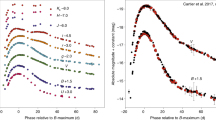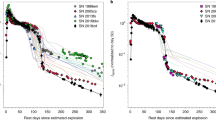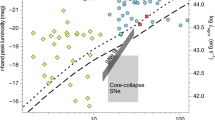Abstract
Arising from A. Rest et al. Nature 482, 375–378 (2012).10.1038/nature10775
During the years 1838–1858, the very massive star η Carinae became the prototype supernova impostor: it released nearly as much light as a supernova explosion and shed an impressive amount of mass, but survived as a star1. In the standard interpretation, mass was driven outward by excess radiation pressure, persisting for several years. From a light-echo spectrum of that event, Rest et al.2 conclude that “other physical mechanisms” are required to explain it, because the gas outflow appears cooler than theoretical expectations. Here we note that (1) theory predicted a substantially lower temperature than they quoted, and (2) their inferred observational value is quite uncertain. Therefore, analyses so far do not reveal any significant contradiction between the observed spectrum and most previous discussions of the Great Eruption and its physics.
Similar content being viewed by others
Main
Rest et al. state that a temperature of 7,000 K was expected, and that 5,000 K is observed. These refer to outflow zones that produced most of the emergent radiation. For the 7,000 K value those authors cite a 1987 analysis by one of us3, but they quote only a remark in the text, not the actual calculated values. According to figure 1 in ref. 3, η Carinae’s Great Eruption should have had a characteristic radiation temperature in the range 5,400–6,500 K, not 7,000 K. (Here we assume mass loss exceeding one solar mass per year and luminosity exceeding 107 solar luminosities1.) The mention of 7,000 K in ref. 3 concerned less extravagant outbursts, and η Carinae was explicitly stated to differ from them. Moreover, to establish a conflict between observations and expectations, new calculations with modernized opacities would be needed.
The approximately 5,000 K temperature ‘observed’ by Rest et al. is based on a derived classification for the light-echo spectrum, using automated cross-correlations with a set of normal supergiant stars. This technique may be suitable for mass-production normal spectra, but any non-routine object requires specific feature-by-feature comparisons instead. One of the first principles of stellar classification is to separate luminosity from temperature criteria, but all the reference stars in this case were far less luminous than η Carinae’s eruption. (Luminosity correlates with surface gravity, which affects gas density and thereby the spectrum.) Furthermore, emission lines appear to be present and may contaminate an automated analysis; but without access to the spectrum we cannot verify this. Rest et al. used a temperature calibration from a 1984 reference4 taken from an even older publication in 19775. Considerable work has been done since then, and for the highest luminosities, each spectral type has a substantial range of possible temperatures—for example, 5,100–6,200 K for the G2–G5 spectral types favoured in their paper6,7,8. The temperature range indicated by stellar classification thus overlaps the theoretical expectations.
Moreover, η Carinae’s eruption was a large-scale mass outflow, not a static atmosphere with definable surface gravity. This distinction quantitatively alters the relation between absorption lines and the underlying continuum. The characteristic radiation temperature T0 in the 1987 theoretical description3 is therefore defined differently from a normal star’s ‘effective temperature’. If spectral types are assigned to outflows, there is no reason to expect their temperatures to coincide with the stellar-atmosphere calibration adopted by Rest et al.1. This is not a question of stellar wind versus explosion; dense winds, stellar eruptions, and opaque explosions are basically alike in their emergent radiation physics1,3, and their density dependences ρ(r) differ in character from normal stellar atmospheres. In conclusion, as far as existing models allow anyone to say, the observed spectrum appears to be consistent with what one expects for a giant eruption with η Carinae’s parameters.
References
Davidson, K., Humphreys, R. M., eds. Eta Carinae and the Supernova Impostors Vol. 384 (Astrophysics and Space Science Library, Springer Media, 2012)
Rest, A. et al. Light echoes reveal an unexpectedly cool η Carinae during its nineteenth-century Great Eruption. Nature 482, 375–378 (2012)
Davidson, K. The relation between apparent temperature and mass-loss rate in hypergiant eruptions. Astrophys. J. 317, 760–764 (1987)
Humphreys, R. M. & McElroy, D. B. The initial mass function for massive stars in the Galaxy and the Magellanic Clouds. Astrophys. J. 284, 565–577 (1984)
Flower, P. J. Transformations from theoretical H-R diagrams to C-M diagrams: effective temperatures, colors and bolometric corrections. Astron. Astrophys. 54, 31–39 (1977)
Soubiran, C. et al. The PASTEL catalogue of stellar parameters. Astron. Astrophys. Suppl. 515, 111–116 (2010)
Cenarro, A. J. et al. Empirical calibration of the near-infrared Ca II triplet—II. The stellar atmosphere parameters. Mon. Not. R. Astron. Soc. 326, 981–994 (2001)
Kovtyukh, V. V. et al. Accurate luminosities for F–G supergiants from Feii/Fei line depth ratios. Mon. Not. R. Astron. Soc. 408, 1568–1575 (2010)
Author information
Authors and Affiliations
Contributions
The authors contributed equally.
Ethics declarations
Competing interests
Declared none.
Rights and permissions
About this article
Cite this article
Davidson, K., Humphreys, R. The Great Eruption of η Carinae. Nature 486, E1 (2012). https://doi.org/10.1038/nature11166
Received:
Accepted:
Published:
Issue Date:
DOI: https://doi.org/10.1038/nature11166
This article is cited by
-
Rest et al. reply
Nature (2012)
Comments
By submitting a comment you agree to abide by our Terms and Community Guidelines. If you find something abusive or that does not comply with our terms or guidelines please flag it as inappropriate.



